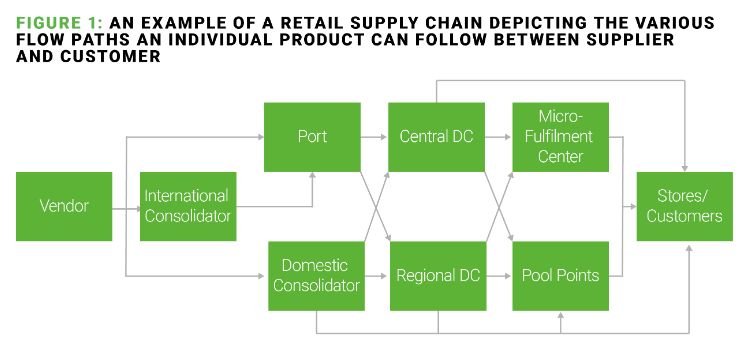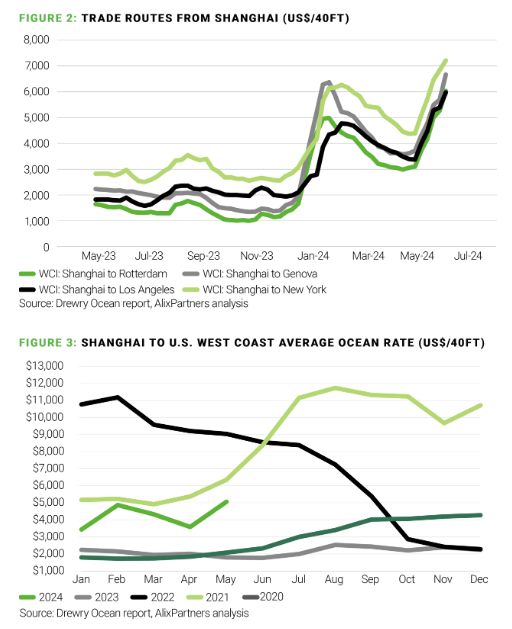In today's dynamic retail landscape, supply chain management has become more complex than ever before. The rise of omnichannel retailing, shifting customer preferences, and global disruptions have introduced complexities beyond what traditional supply chains were designed to handle.
Many retailers still rely on a "one-size-fits-all" and cost-focused supply chain with regional distribution capabilities. However, as supply chain dynamics become more intricate, strategies related to product flow are evolving to mitigate various challenges faced across the industry. Retailers that have mastered segmented product flows through optimized paths for each product category have been able to dramatically improve inventory turns, reduce touches, and shrink network footprints while enhancing service levels and reducing end-to-end costs.
In this article, we'll explore some common pressures faced in the retail landscape and discuss product flow tactics to address them.
Key questions retailers need to ask
When designing a retail supply chain strategy, several fundamental questions guide decision-making:
1. Assortment: What products do they offer?
Retailers must carefully consider the range of products that are offered, which will inform the optimal inventory levels for each product category. This means understanding the characteristics of each product, such as its handling requirements (e.g., perishable goods vs. durable items), seasonality (e.g., winter clothing vs. summer swimwear), and product lifecycles (e.g., trendy vs. evergreen items). Ultimately, the assortment shapes inventory requirements, affecting procurement, storage, and distribution decisions.
2. Customers and stores: What are customers' service expectations?
For retailers grappling with the complexities of omnichannel, emphasizing efficiencies associated with servicing stores and consumers alike is essential. What level of customer service is expected? Is inventory placed strategically to meet customer demand? Are they optimized for last-mile delivery?
3. Suppliers: What does inbound flow look like?
Often overlooked, the inbound flow of goods is foundational in setting the supply chain up for success. Longer lead times may require higher safety stock levels. Are suppliers consistent in meeting delivery schedules? Reliable suppliers contribute to smoother operations. Building strong relationships with suppliers ensures better communication and coordination and reduces costs through greater efficiency.
4. Current capabilities: What is their strategic direction?
Understanding current capabilities and challenges is crucial in defining future strategy. Looking at technology, do they have robust systems for inventory management, demand forecasting, and order processing? Do they have the right infrastructure? Is the distribution network optimized? Are warehouses strategically located? Do they have skilled supply chain professionals who can drive improvements?
Based on this assessment, retailers can define their strategic direction. Is the aim faster delivery, cost reduction, sustainability, or other goals? The supply chain strategy should align with these objectives.

Common problems and network flow strategies to resolve
After answering these key questions, retailers should refresh their network strategy to identify strategies to alleviate pain points. Let's take a look at some common pressures that retailers face and network/product flow tactics to mitigate them:
1. Speed to customer
Challenge: Customers expect lightning-fast deliveries, whether they shop online or visit physical stores. Retailers must find ways to accelerate order fulfillment.
Proven solutions: Eliminating touchpoints along the distribution chain can be one of the most effective ways to reduce time to fulfill. Strategies such as DC bypass or vendor direct delivery can help eliminate unnecessary flows and reduce lead time, not just by days but even weeks.
Forward deploying inventory is another strategy. Pushing product closer to stores and/or consumers can reduce the time between order generation and delivery. Leveraging micro-fulfillment centers in urban hubs or pool points near high-velocity stores can be effective strategies. However, identifying the right product candidates is crucial due to space and planning complexity, and the need to avoid trapping markdown products in forward-deployed locations/stores.
2. High cost
Challenge: Across all eras of retail, supply chains have faced pressures to reduce costs while still meeting customer needs. The ocean container cost charts below illustrate how costs can be unpredictable and highly variable over time. An effective supply chain should be able to not only operate at low costs, but be able to react to dynamic cost environments. (link to supply chain market)

Proven solutions: A number of strategies can help minimize transportation costs. Setting up regional distribution capabilities to optimize transportation routes is one such strategy. Using product-specific distribution centers (DCs) to handle products with specific challenges or characteristics is another. These purpose-built locations can more easily pay off automation or material handling investments.
Unique challenges faced by a small percentage of the assortment can be met by balancing fixed and variable costs by leveraging third-party logistics. More sophisticated regional distribution capabilities can also reduce markdown liabilities by creating more agile replenishment flows, and duty optimization strategies may be able to fund expedited delivery direct to consumer through reduced tariffs.
3. Inventory and capacity issues
Challenge:Many retailers are facing pressures from rising inventory levels. The carrying costs and opportunity costs of inventory are both exacerbated by the current interest rate environment. Capacity constraints and operational inefficiencies are additional headwinds faced by retailers with high inventory levels.
Proven solutions:Reduce inventory holding requirements by increasing cross-docking capabilities and identifying opportunities for enhanced vendor managed or drop ship capabilities. Use multi-echelon inventory strategies to consolidate and reduce safety stock requirements on slow moving products or items with inherently unpredictable forecasts.
4. Inventory availability
Challenge:Constantly evolving assortments, customer needs, and upstream supply chain disruptions create challenges for planning inventory availability.
Proven solutions:Investing in inventory planning is critical for managing inventory flows. Retailers must adapt their buying patterns to align with sales, current inventory levels, and returns. This requires more sophistication than placing a purchase order and waiting for the inventory to sell and requires adapting purchasing patterns and analyzing inventory rebalance opportunities.
Specialized stocking sites can help mitigate some of the challenges associated with having products available on time. For instance, coastal holding facilities can act as import hubs that effectively reduce the lead time associated between time of allocation and flow of product to customers and stores.
Finally, factor in returns. Return flows can be significant sources of inventory for certain locations and should be appropriately planned into the forecasted stock levels.
Moving beyond the "one-size-fits-all" supply chain model
Constantly evaluating supply chain strategies and capabilities is imperative for any retailer. Keeping up with evolving dynamics in customer expectations, product characteristics, and the competitive landscape requires investment in analytics and infrastructure, as well as an openness to change.
Retailers must set the foundation for their network and product flow strategies through enhanced master data management, advanced analytics capabilities, focus, and precision in SI&OP (Sales, Inventory, and Operations Planning), and organizational structures and leadership to drive results.
Retailers that effectively develop these skills and refine product flow will be well poised for success in this ongoing era of disruption.
The content of this article is intended to provide a general guide to the subject matter. Specialist advice should be sought about your specific circumstances.
We operate a free-to-view policy, asking only that you register in order to read all of our content. Please login or register to view the rest of this article.



